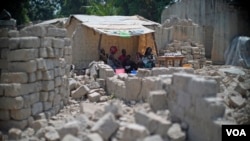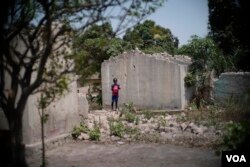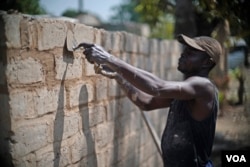The government of the Central African Republic shut down the displaced persons' camp at the airport in its capital and sent the camp's 30,000 remaining residents packing. Many have returned to their old neighborhoods, but say they do not feel safe.
Djiedune Kupato returned home with his wife and eight children late last month. Now his children walk five kilometers to get to school. Kupato worries about their safety, with militias still active in the area.
Kupato says if the government had prepared better for them to return, they would have water near their house. He says they do not have a good house to live in, as it has been destroyed. Instead, the family sleeps under a tarp.
Meanwhile, bulldozers have leveled what remained of the camp at Bangui M'poko International Airport.
At its height in 2014, the camp was home to more than 130,000 people, many Christian. Central African Republic descended into chaos after mostly Muslim Seleka rebels seized power in March 2013. Efforts to oust Seleka in December of that year kicked off deadly communal violence in the capital and other parts of the country.
The C.A.R. president visited the camp at the end of 2016 and told the remaining residents it was time to go home. Authorities said it was unsafe for so many people to be living right next to an airstrip. The government gave each family about $85 to leave, which covers about three months' rent in Bangui.
The Oxfam advocacy manager in C.A.R., Isidore Ngueuleu, says the government had no broader strategy to support returnees.
"Basically in these neighborhoods, there is no home," Ngueuleu said. "Everything has been destroyed in this neighborhood. So people have decided to return there and start back from zero."
In the Fondo area of PK5, some residents use UNHCR tents to sleep in while they rebuild their homes. Newly-made bricks are stacked neatly outside many burned out and demolished homes in the area.
PK5 was once at the epicenter of the violence in Bangui, and tensions are still high.
Therese Ngalema, 67, came back in mid-January.
She says there is no security — or even a government checkpoint — in the neighborhood.
Ngalema says she wants more patrols by U.N. troops. Officials from a U.N. peacekeeping operation known as MINUSCA told VOA that troops do reinforce their presence when there is a threat.
An Oxfam study found that reports of violence, like assaults and rape, have increased nearly 50 percent in PK5 since October. In early February, a Muslim gang leader called Big Man was killed in an operation by state security forces. His supporters burned down houses and killed several people, including a pastor.
To reach schools and health services, some residents have to go through areas controlled by Muslim militias. Access to water and food is also severely limited.
The government says it will follow up with the returnees in the coming months to determine their needs, and will work with humanitarian organizations to coordinate additional services.
The experience of these recent returnees to PK5 may be just a taste of the challenges ahead. At the peak of the crisis in the C.A.R., nearly one million people were internally displaced and another half million fled to neighboring countries.
Today, more than 400,000 internally displaced persons have not returned home.












